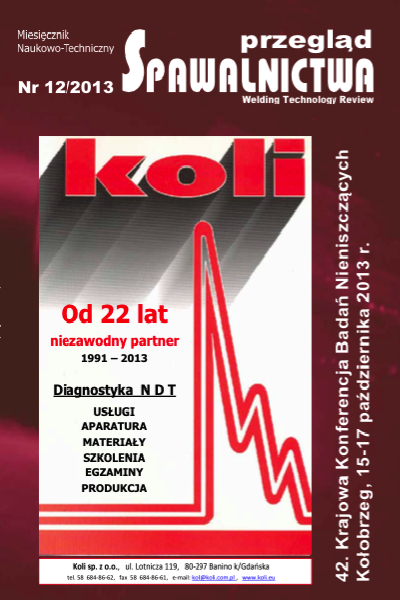Wykorzystanie technik bazujących na teorii zbiorów przybliżonych w procesie detekcji i klasyfikacji niezgodności spawalniczych
Main Article Content
Abstract
Przetwarzanie znaczących ilości informacji pochodzących z obrazów radiograficznych oraz automatyczne wykrywanie wad połączeń spawalniczych z dużą dokładnością jest możliwe dzięki zastosowaniu rozwiązań opartych na teorii zbiorów przybliżonych oraz zastosowaniu jej w systemach komputerowych, które umożliwiają szybkie przetwarzanie znaczących ilości danych. Wspomniana metoda ma solidne podstawy matematyczne, których zastosowanie umożliwia określenie istotności atrybutów mających znaczenie dla identyfikacji niedoskonałości, natomiast ostateczna ocena reguł tworzy bazę wiedzy umożliwiająca komputerowe wskazywanie określonej klasy wady spoiny. Opisana technika umożliwiła klasyfikację wad w bardzo wysoką dokładnością dla rzeczywistych danych pochodzących ze zdjęć rentgenowskich połączeń spawalniczych.
The use of rough sets theory in process of detection and classification of welding imperfections
abstract
Processing of large amount of information deriving from radiographic images and automatically detecting of welding joints imperfections with high accuracy is possible by applying solutions based on rough sets theory and usage of this theory on computer systems that are capable to make fast calculations on huge number of information. The theory posses solid and confirmed mathematical foundation that allows applying it for calculation of attribute importance that have huge significance for identification of weld imperfections, whereas final extracting rules creates knowledge base that gives possibility for computer aided pointing specific class of weld imperfection. Technique that is descried in the paper was capable of classification of weld defects with very high accuracy for real data originating from radiographic images of weld joints.
Downloads
Article Details
Creative Commons CC BY 4.0 https://creativecommons.org/licenses/by/4.0/
Welding Technology Review (WTR) articles are published open access under a CC BY licence (Creative Commons Attribution 4.0 International licence). The CC BY licence is the most open licence available and considered the industry 'gold standard' for open access; it is also preferred by many funders. This licence allows readers to copy and redistribute the material in any medium or format, and to alter, transform, or build upon the material, including for commercial use, providing the original author is credited.
References
Inuiguchi M., Generalizations of Rough Sets and Rule Extraction, Springer, 2005.
Bazan J., Synak P., Wrobleski J., Rough Set Algorithms in Classification Problem, Springer, 2000.
Pawlak Z., Rough Sets Theoretical Aspects of Reasoning about Data, Kluwer Academic Publishers, 1991.
Olson D., Delen D., Advanced Data Mining Techniques, Springer, 2008.
Duntsch I., Gediga G., Rough set data analysis, Methodos Publisher, 2000.
Pawlak Z.: Some issues on rough sets, Springer Science, 2005
S. Bandyopadhyay, U.Maulik, L.B.Holder, D.J.Cook Advanced Methods for Knowledge Discovery from Complex Data, Springer, 2005.
Han J., Kamber M.: Data mining concepts and techniques, Morgan Kaufman, 2006.
Michie D., Spiegelhalter D.J., Taylor C.C.: Machine Learning, neural and Statistical Classification, Ellis Horwood, new York, 1994.
